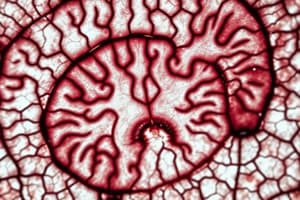Podcast
Questions and Answers
¿Qué propiedad de la LTP implica la interacción de múltiples neuronas presinápticas y postsinápticas de manera coordinada?
¿Qué propiedad de la LTP implica la interacción de múltiples neuronas presinápticas y postsinápticas de manera coordinada?
- Asociatividad
- Cooperatividad (correct)
- Plasticidad neuronal
- Especificidad de entrada
¿Qué propiedad de la LTP se refiere a la capacidad de mejorar solo las conexiones sinápticas involucradas en una experiencia particular?
¿Qué propiedad de la LTP se refiere a la capacidad de mejorar solo las conexiones sinápticas involucradas en una experiencia particular?
- Receptividad sináptica
- Cooperatividad
- Asociatividad
- Especificidad de entrada (correct)
¿Cuál es la función principal de la asociatividad en la LTP?
¿Cuál es la función principal de la asociatividad en la LTP?
- Evitar la formación de nuevas memorias
- Bloquear la neurotransmisión
- Facilitar el establecimiento de asociaciones entre diferentes aspectos de una memoria (correct)
- Eliminar las conexiones neuronales débiles
¿Por qué es esencial la LTP para el aprendizaje y la memoria?
¿Por qué es esencial la LTP para el aprendizaje y la memoria?
¿En qué región del cerebro se produce principalmente la LTP?
¿En qué región del cerebro se produce principalmente la LTP?
¿Qué propiedad de la LTP asegura que los nuevos aprendizajes no interfieran con el conocimiento previo?
¿Qué propiedad de la LTP asegura que los nuevos aprendizajes no interfieran con el conocimiento previo?
¿Cuál de las siguientes opciones describe mejor la función del hipocampo en los procesos cognitivos?
¿Cuál de las siguientes opciones describe mejor la función del hipocampo en los procesos cognitivos?
¿Cuál de las siguientes afirmaciones describe correctamente el mecanismo de la potenciación a largo plazo (LTP) en el aprendizaje y la memoria?
¿Cuál de las siguientes afirmaciones describe correctamente el mecanismo de la potenciación a largo plazo (LTP) en el aprendizaje y la memoria?
¿Qué papel desempeña la vía de las colaterales de Schaffer en la inducción de la LTP?
¿Qué papel desempeña la vía de las colaterales de Schaffer en la inducción de la LTP?
¿Qué papel desempeña el factor neurotrófico derivado del cerebro (BDNF) en la inducción y mantenimiento de la LTP?
¿Qué papel desempeña el factor neurotrófico derivado del cerebro (BDNF) en la inducción y mantenimiento de la LTP?
¿Cuál de las siguientes afirmaciones describe correctamente la relación entre la neuroplasticidad y la formación de memoria?
¿Cuál de las siguientes afirmaciones describe correctamente la relación entre la neuroplasticidad y la formación de memoria?
¿Cuál de las siguientes afirmaciones resume mejor el papel del hipocampo y la LTP en el aprendizaje y la memoria?
¿Cuál de las siguientes afirmaciones resume mejor el papel del hipocampo y la LTP en el aprendizaje y la memoria?
Flashcards are hidden until you start studying
Study Notes
Hippocampal LTP and Learning
Understanding Long-Term Potentiation (LTP)
Long-term potentiation (LTP) is a process in which brief periods of synaptic activity can lead to a long-lasting increase in synapse strength. It is crucial for learning and memory in mammals, as it enables the strengthening of neural connections related to specific experiences and helps in forming new associations between them. LTP has three essential properties: cooperativity, input specificity, and associativity.
Cooperativity
Cooperativity involves the interaction of multiple presynaptic and postsynaptic neurons in a coordinated manner, allowing for the development of stronger neural connections. This property is vital for encoding and recalling information effectively.
Input Specificity
Input specificity refers to the ability of LTP to enhance only the synaptic connections involved in a particular experience, while leaving others unchanged. This feature ensures that new learning doesn't interfere with existing knowledge, thereby maintaining the accuracy of memory storage.
Associativity
Associativity is the mechanism that links the activation of different synaptic inputs within a short period. This function makes it easier to remember relationships between various aspects of a memory by facilitating the establishment of associations between them.
The Role of the Hippocampus
The hippocampus, specifically in the CA1 region, is responsible for several cognitive processes, such as memory storage and retrieval. LTP was first identified and studied extensively in the mammalian hippocampus due to its importance in these functions.
Learning Mechanisms
LTP serves as a cellular correlate of learning and memory by strengthening synaptic connections. Its induction requires the cooperation of afferent fibers, such as the Schaffer collateral pathway, which is linked to the NMDA receptor system. The positive feedback loop of local protein synthesis, particularly involving brain-derived neurotrophic factor (BDNF), plays a significant role in LTP induction and maintenance.
Neuroplasticity and Memory Formation
Neuroplasticity, the brain's ability to adapt and reorganize neural connections in response to new experiences and changing environments, is essential for learning and memory. LTP is a critical component of neuroplasticity, allowing for the formation of long-lasting memories.
In summary, hippocampal LTP is a vital mechanism for learning and memory, enabling the strengthening of specific neural connections through input specificity, cooperativity, and associativity. The hippocampus plays a central role in this process, and neuroplasticity facilitates the formation of long-lasting memories via LTP induction. Understanding these mechanisms can provide valuable insights into how we learn, retain information, and adapt to new experiences.
Studying That Suits You
Use AI to generate personalized quizzes and flashcards to suit your learning preferences.



